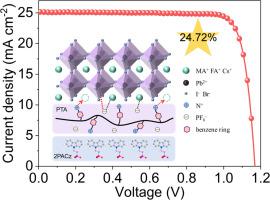当前位置:
X-MOL 学术
›
J. Mater. Sci. Technol.
›
论文详情
Our official English website, www.x-mol.net, welcomes your feedback! (Note: you will need to create a separate account there.)
Enhancing efficiency and stability of inverted perovskite solar cells through synergistic suppression of multiple defects via poly(ionic liquid)-buried interface modification
Journal of Materials Science & Technology ( IF 11.2 ) Pub Date : 2024-06-28 , DOI: 10.1016/j.jmst.2024.05.069 Yijun Bai , Tong Wang , Jiabao Yang , Xingyu Pu , Bingxiu Xue , Hui Chen , Xilai He , Guangpeng Feng , Shiyao Jia , Jianbo Yin , Qi Cao , Xuanhua Li
Journal of Materials Science & Technology ( IF 11.2 ) Pub Date : 2024-06-28 , DOI: 10.1016/j.jmst.2024.05.069 Yijun Bai , Tong Wang , Jiabao Yang , Xingyu Pu , Bingxiu Xue , Hui Chen , Xilai He , Guangpeng Feng , Shiyao Jia , Jianbo Yin , Qi Cao , Xuanhua Li

|
The stability of perovskite solar cells (PSCs) is adversely affected by nonradiative recombination resulting from buried interface defects. Herein, we synthesize a polyionic liquid, poly(p-vinylbenzyl trimethylammonium hexafluorophosphate) (PTA), and introduce it into the buried interface of PSCs. The quaternary ammonium cation (N(–CH)) in PTA can fill the vacancies of organic cations within the perovskite structure and reduce shallow energy level defects. Additionally, the hexafluorophosphate (PF) in PTA forms a Lewis acid-base interaction with Pb in the perovskite layer, effectively passivating deep energy level defects. Furthermore, hydrogen bonding can be established between organic cations and the PF anion, preventing the formation of shallow energy level defects. Through this synergistic mechanism, the deep and shallow energy level defects are effectively mitigated, resulting in improved device performance. As a result, the resulting treated inverted PSC exhibits an impressive power conversion efficiency (PCE) of 24.72 %. Notably, the PTA-treated PSCs exhibit remarkable stability, with 88.5 % of the original PCE retained after undergoing heat aging at 85 °C for 1078 h, and 89.1 % of the initial PCE maintained following continuous exposure to light for 1100 h at the maximum power point. Synergistically suppressing multiple defects at the buried interface through the use of polyionic liquids is a promising way to improve the commercial viability of PSCs.
中文翻译:

通过聚(离子液体)埋入界面改性协同抑制多种缺陷,提高倒置钙钛矿太阳能电池的效率和稳定性
钙钛矿太阳能电池(PSC)的稳定性受到掩埋界面缺陷导致的非辐射复合的不利影响。在此,我们合成了一种聚离子液体,聚(对乙烯基苄基三甲基六氟磷酸铵)(PTA),并将其引入PSC的埋入界面中。 PTA中的季铵阳离子(N(–CH))可以填充钙钛矿结构内有机阳离子的空位,减少浅能级缺陷。此外,PTA中的六氟磷酸盐(PF)与钙钛矿层中的Pb形成路易斯酸碱相互作用,有效钝化深能级缺陷。此外,有机阳离子和PF阴离子之间可以建立氢键,防止浅能级缺陷的形成。通过这种协同机制,有效减轻深浅能级缺陷,从而提高器件性能。因此,经过处理的倒置 PSC 表现出高达 24.72% 的令人印象深刻的功率转换效率 (PCE)。值得注意的是,经过PTA处理的PSC表现出显着的稳定性,在85℃热老化1078小时后保留了88.5%的原始PCE,并且在最大连续暴露于光1100小时后保留了89.1%的初始PCE微软幻灯片软件。通过使用聚离子液体协同抑制掩埋界面处的多种缺陷是提高PSC商业可行性的一种有前途的方法。
更新日期:2024-06-28
中文翻译:

通过聚(离子液体)埋入界面改性协同抑制多种缺陷,提高倒置钙钛矿太阳能电池的效率和稳定性
钙钛矿太阳能电池(PSC)的稳定性受到掩埋界面缺陷导致的非辐射复合的不利影响。在此,我们合成了一种聚离子液体,聚(对乙烯基苄基三甲基六氟磷酸铵)(PTA),并将其引入PSC的埋入界面中。 PTA中的季铵阳离子(N(–CH))可以填充钙钛矿结构内有机阳离子的空位,减少浅能级缺陷。此外,PTA中的六氟磷酸盐(PF)与钙钛矿层中的Pb形成路易斯酸碱相互作用,有效钝化深能级缺陷。此外,有机阳离子和PF阴离子之间可以建立氢键,防止浅能级缺陷的形成。通过这种协同机制,有效减轻深浅能级缺陷,从而提高器件性能。因此,经过处理的倒置 PSC 表现出高达 24.72% 的令人印象深刻的功率转换效率 (PCE)。值得注意的是,经过PTA处理的PSC表现出显着的稳定性,在85℃热老化1078小时后保留了88.5%的原始PCE,并且在最大连续暴露于光1100小时后保留了89.1%的初始PCE微软幻灯片软件。通过使用聚离子液体协同抑制掩埋界面处的多种缺陷是提高PSC商业可行性的一种有前途的方法。
















































 京公网安备 11010802027423号
京公网安备 11010802027423号